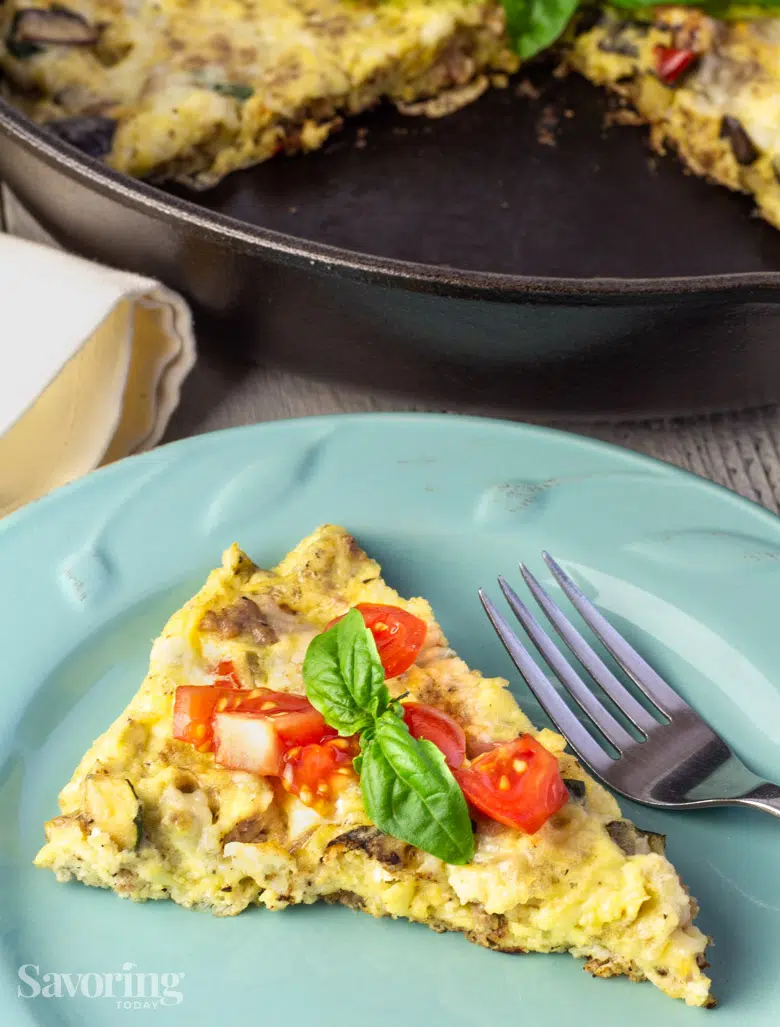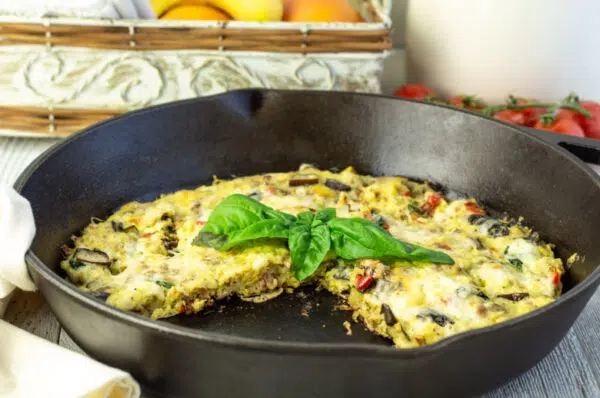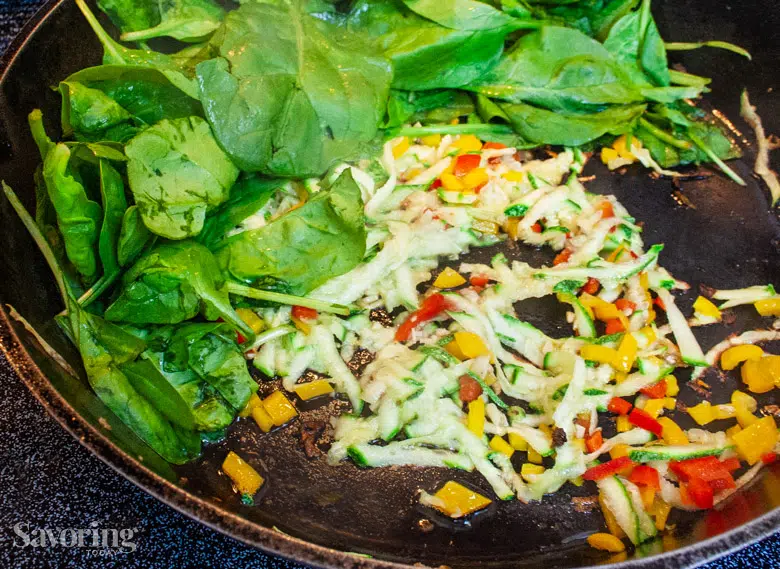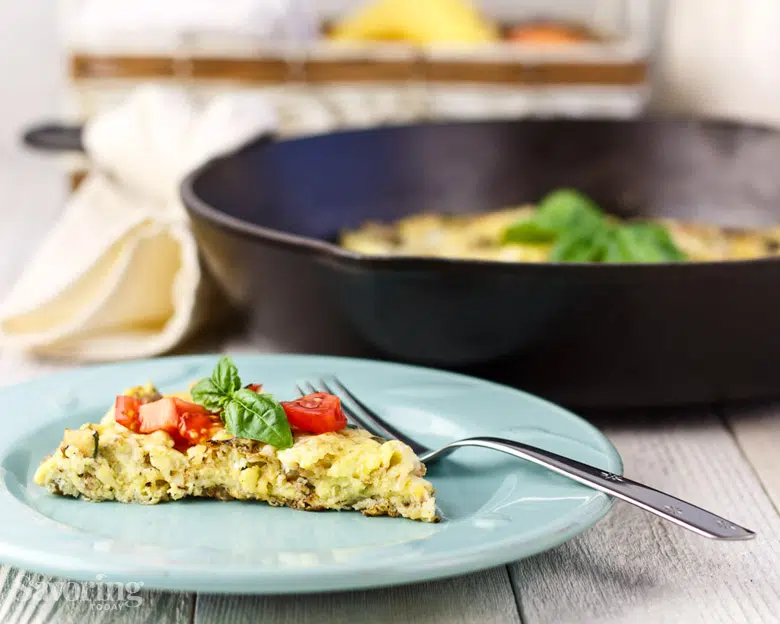Making a frittata is supposed to be fast and simple!
We show you how to make it entirely from scratch or the traditional way with leftovers to satisfy your appetite at breakfast, lunch, or dinner.

A Frittata is a choose-your-own-path breakfast dish that begins with the most basic ingredients—butter, eggs, salt— and from there, it’s all about what suits your needs and preferences.
Traditionally, a frittata is a use-up-leftovers thing, not a formal or precise dish and it is the use of leftovers that makes it especially quick and easy to prepare.
It is such a staple in Italy cooks will carve off a small portion of the dinner meal, so there’s something for a frittata the next day (so clever!). We teach this same kind of plan for the next meal in our Monthly Cooking Course.
Classic frittata recipes are somewhat like “fried” scambled eggs—cooked and sturdy enough to flip and brown both sides. In Italy, it’s even sometimes served as a sandwich (panino con la frittata).
Our basic frittata recipe is inspired by more traditional recipes, but does not include flipping or cooking the eggs until browned simply because that is not our preferred texture.
In this frittata, the eggs are soft and tender, holding all those yummy add-ins together under a light blanket of cheese.
While it certainly shines as a morning meal, this egg dish also satisfies as a nourishing, hassle-free dinner after a long day, making it a great solution for busy weeknights. You might even try using a frittata to hide a few veggies for the kids, as the texture of the eggs can be appealing to young children.
Table of contents

What is the difference between a FRITTATA, an OMELET, and a QUICHE?
Frittatas, omelets, and quiche are all egg-based dishes, however, the dairy content and cooking methods are quite different. We’ve included the simple at-a-glance table below to make it easy to distinguish the differences.
| Differences | FRITTATA | QUICHE | OMELET |
|---|---|---|---|
| Dairy Full-Fat Ratio (cream, milk, sour cream) | 1/4 cup of dairy for every 6 eggs (if added) | 1/4 cup of dairy for every 1 large egg (a must) | 1 tablespoon diary for every 1 large egg (if added) |
| Skillet or Baking Pan | cast iron or non-stick skillet (oven-safe) | baking dish or pie pan | smooth, non-stick skillet |
| Cooking Method | stovetop or oven | oven | stovetop |
| Cook Time | 5-20 minutes, depending on using leftovers or fresh add-ins | 40-50 minutes | 5 minutes |
| Fillings / Add-ins | eggs poured over 2 cups pre-cooked meats, vegetables, and 1 cup cheese | eggs poured over 1 cup pre-cooked meats, vegetables, and 1 cup cheese | eggs are gently cooked before folding in 1/2 cup of pre-cooked meat, vegetables, and cheese |
| Servings | 6-8 | 6-8 (more if prepared in a larger baking dish) | 1-2 |
| Crust | no crust | traditionally with crust; sometimes crustless | no crust |
| Texture | firmer, fully set | soft, creamy, custard-like | soft, velvety, slightly underdone in the center |
TIP: The best frittata should be light and fluffy in texture with a bit of spring to it. It is cooked when the eggs at the center of the skillet have set and just barely solidified.

What Goes Into a Frittata
Frittatas are an excellent way to use leftovers or create a fresh, inspired dish entirely from scratch. Some might call it the pizza of egg dishes and really anything goes. Depending on what I have in the fridge, I sometimes use up leftovers in tandem with a few fresh ingredients.
Recommended LEFTOVER ADD-INS
- Cooked bacon, ham, sausage, steak, roast beef, or grilled chicken
- Grilled, roasted or sautéed vegetables: broccoli, cauliflower, all varieties of mushrooms, asparagus, onion, tomato, kale, spinach, leeks, zucchini, bell peppers. Note: All vegetables should be cooked and seasoned before adding to the frittata.
- Caramelized onion or roasted garlic.
- Potatoes and root vegetables from Pot Roast
- Stuffed bell peppers
- Portabella mushroom with vegetable stuffing
- Cheese and spinach stuffed manicotti—it is common in Italy to include pasta in frittatas.
- Creamy scalloped ham and vegetables
- Vegetable Tian
- Italian-Style Stuffed Zucchini
- Prosciutto-wrapped caprese salad bites
- Roasted Rosemary Fingerling Potatoes
- Parmesan & Herb Zucchini Sticks
- Roasted Spaghetti Squash with Tomato, Basil and Feta
Recommended FRESH ADD-INS
- Fresh herbs and aromatics like thyme, basil, cilantro, parsley, chives, savory, green onion, leek, garlic
- Fresh greens like spinach, rainbow chard, Tuscan kale, or arugula (should be wilted before adding)
- Fresh tomatoes and vegetables like zucchini, bell pepper, asparagus, mushrooms (should be cooked before adding)
- Sun-dried tomatoes, canned artichokes, deli olives (drained)
- Cheeses, like goat cheese, cheddar, feta, pepper jack, gouda, gruyere, brie, and parmesan. Cheese can go directly into the frittata mixture or add towards the end of baking for optimal meltiness.
- Smoked ham, prosciutto, speck are fully cooked and can be added without pre-cooking
- Bacon or sausage (thoroughly cook before adding)
TIP: All fresh meat or vegetables should be cooked and seasoned before being added to the frittata. When using any fresh ingredients, be sure to include time for the pre-cooking of things like potatoes, bacon, and vegetables. Everything that requires cooking beforehand should have a tender texture and be seasoned separately to maximize flavor.

Suggested FLAVOR COMBOS
- Heirloom tomato and goat cheese
- Ham and Swiss cheese
- Steak, hashbrowns, and cheddar cheese
- Spinach, zucchini, bell pepper, roasted garlic, and gruyere cheese
- Potato, leek, and parmesan cheese
- Sausage, mushroom, pepper Jack cheese
- Bacon, arugula, tomato, and gouda cheese
- Grilled chicken, green chile, and Monterey Jack cheese
- Pesto and mozzarella cheese
- Asparagus, caramelized onion, and brie cheese




How to Make a Frittata STEP BY STEP
There are two simple methods to make a frittata, the first uses leftovers and the second uses fresh ingredients that may need a little more cooking. However, the basic frittata recipe remains the same. I add up to 2 cups of leftover cooked vegetables and meat or up to 3 cups of fresh ingredients.
SPECIAL EQUIPMENT: Use a well-seasoned 10-12 inch cast-iron skillet or another oven-safe skillet to cook the frittata.
STEPS for LEFTOVER ADD-INS
- Beat eggs with the salt and pepper until combined (if adding cream, include it now). Allow the salted eggs to sit for 15 minutes while prepping the add-ins.
- Warm leftovers over medium heat in a cast iron skillet.
- Add in any herbs and the remaining butter and reduce the heat to medium-low.
- Set an oven rack about 8 inches under the oven broiler and turn the broiler on high.
- Sprinkle the cheese over the warmed add-ins and pour eggs over the top.
- After a minute or two check the edges with a spatula and once they start to set, gently pull the edges into the middle of the skillet and allow the uncooked egg to run toward the edge of the pan.
- Continue to move the eggs in the skillet until most of the egg has set, like runny scrambled eggs.
- Top with more cheese and place the skillet under the broiler for 2-3 minutes to finish cooking the eggs and lightly brown the top.

STEPS for FRESH ADD-INs:
- Beat eggs with the salt and pepper until combined (if adding cream, include it now). Allow the salted eggs to sit for 15 minutes while prepping the add-ins.
- Brown any raw meat over medium heat and cut or crumble the cooked meat into small pieces and set aside.
- Remove all but 1 tablespoon of fat from the skillet or add 1 tablespoon of butter and heat the skillet over medium heat. If using onions, add those first and cook for around 5 minutes to soften.
- Add other raw vegetables and cook until softened and tender. Season with salt and pepper, and add in any herbs at this point.
- Return the cooked meat to the skillet with the vegetables and the final tablespoon of butter. Reduce the heat on the stove to medium-low.
- Set an oven rack about 8 inches under the oven broiler and turn the broiler on high.
- Sprinkle the cheese over the warmed add-ins and pour eggs over the top.
- After a minute or two check the edges with a spatula and once they start to set, gently pull the edges into the middle of the skillet and allow the uncooked egg to run toward the edge of the pan.
- Continue to move the eggs in the skillet in this way until most of the egg has set, like runny scrambled eggs.
- Top with more cheese and place the skillet under the broiler for 3-4 minutes to finish cooking the eggs and to brown the top.
TIP: Always season the add-ins with salt and pepper as well as the beaten egg mixture. This is important as it balances the seasoning over the entire dish.
Frittata Recipe TIPS & VARIATIONS
- SPECIAL EQUIPMENT: Use a well-seasoned 10-12 inch cast-iron skillet or another oven-safe skillet to cook the frittata.
- Add salt to the eggs 15 minutes before cooking.
- If adding dairy, use 1/4 cup for every 6 large eggs.
- Use only full-fat cream, milk, sour cream, etc., to avoid watering down the eggs.
- All fresh ingredients like meat or vegetables should be cooked prior to adding.
- Garnish with fresh toppings like sliced avocado, fresh tomato, chives, basil pesto, crushed red pepper flakes, marinated mushrooms, olives, feta, or ricotta cheese
- Make ahead, cool, cover with foil, and refrigerate for up to 5 days. Reheat in the microwave for 30 seconds.
WHY Wait after Salting the Eggs?
Are you ready for a science lesson? A small but important step in this whole process is salting your eggs early. One of my favorite cookbooks, The Food Lab: Better Home Cooking Through Science by J. Kenji López-Alt, is an excellent resource for the home cook that walks you through the science of cooking. This book has an entire section on cooking eggs, and this egg secret is a game-changer.
Salt does more than heighten the flavor of food; it helps balance moisture. When you add the salt is as important as the salt itself. Here’s a brief overview of the magic in this subtle step:
- Allowing the salt time to work creates a reaction within the proteins of the eggs that reduce their attraction to one another, creating a looser bond and retaining more moisture. This makes the least watery, most tender eggs—you won’t even be tempted to add more dairy.
- If you can’t wait 15 minutes, the next best option is to mix the salt in right before adding the eggs to the pan. The eggs will still be moderately tender and not watery, just not as perfect.
- Resist adding salt to the eggs once they start cooking. Salting eggs late in the game causes them to weep moisture, creating that not-so-lovely dry egg texture.
TIP: When reheating a frittata, cover with foil and place in the oven at 350F for 20 minutes to heat through or microwave in 30-second intervals until warm.
Add Full-Fat Dairy for Fluffier Frittatas
Dairy fats slow the speed of cooking in eggs and keep the proteins from bonding too tightly, which results in a more creamy texture.
Our frittata recipe does not call for adding cream or milk, but some recipes do to create a fluffier result, which is simply a matter of preference.
If you do add cream, milk, sour cream, creme fraise, or plain yogurt, use only full-fat varieties as the fats are where the science happens! Non-fat and 2% loosen the texture too much and leave it a bit watery.
TIP: In the case of a frittata recipe, 1/4 cup of full-fat dairy for every 6 eggs is the way to go if you’re looking for a creamier texture.

More Delicious Breakfast Recipes
This post may contain affiliate links. See our disclosure policy for more information.
Basic Frittata
Ingredients
- 2 tablespoons butter
- 6 large eggs
- 1/4 teaspoon sea salt
- 1/4 teaspoon ground black pepper
- 1/2 cup grated cheese any favorite, plus more for topping
- 1 teaspoon dried herbs , or 2 tablespoons chopped fresh herbs
- 2 cups cooked, leftover add-ins (see notes) , or 3 cups fresh add-ins
Instructions
For LEFTOVER ADD-INS
- In a small bowl, beat eggs with the salt and pepper until combined (if adding cream, include it now). Allow the salted eggs to sit for 15 minutes while prepping the other ingredients.In a 10 or 12-inch cast iron or other oven-safe skillet, melt 1 tablespoon butter over medium heat and warm leftover vegetables or meat 2 to 3 minutes. Season with salt and pepper, if needed (this is in addition to the salt and pepper added to the eggs), and add any herbs at this point.Add the remaining tablespoon of butter to the skillet and reduce heat to medium-low. Set an oven rack about 8 inches under the oven broiler and turn broiler on HI.
- Sprinkle 1/2 cup of cheese over the warmed add-ins and pour eggs over the top. After a minute or two, check the edges of the eggs with a spatula and once they start to set, gently pull the edges into the middle of the skillet allowing the uncooked part of the eggs to run toward the edges.
- Continue to move the eggs in the skillet in this way until most of the eggs begin to set, like runny scrambled eggs. Add more cheese to the top of the eggs if desired, then transfer to the oven under the broiler for 2 to 3 minutes to finish cooking the eggs until set (no jiggle in the middle) or lightly browned to preference.
For FRESH ADD-INS
- In a small bowl, beat eggs with the salt and pepper until combined (if adding cream, include it now). (Allow the salted eggs to sit for 15 minutes while prepping the other ingredients.) In a 10 to 12-inch cast iron or other oven-safe skillet, brown any raw meats. Cut or crumble cooked meat into small pieces and set aside. Remove all but 1 tablespoon of fat from the skillet or add 1 tablespoon of butter and heat the skillet over medium heat. If using onions, add those first and cook until translucent, about 5 minutes.
- Add any other raw vegetables and cook until softened and tender (potatoes should be boiled until tender before adding to the skillet). Season with salt and pepper, to taste (this is in addition to the salt and pepper added to the eggs). Add any herbs at this point. Once the vegetables are tender, add any meat back to the skillet along with the remaining tablespoon of butter, and reduce heat to medium-low. Set an oven rack about 8 inches under the oven broiler and turn broiler on HI
- Sprinkle the cheese over the cooked add-ins and pour eggs over the top. After a minute or two, check the edges of the eggs with a spatula and once they start to set, gently pull the edges into the middle of the skillet allowing the uncooked part of the eggs to run toward the edges.
- Continue to move the eggs in the skillet in this way until most of the eggs begin to set, like runny scrambled eggs. Add more cheese to the top of the eggs if desired, then transfer to the oven under the broiler for 2 to 3 minutes to finish cooking the eggs until set (no jiggle in the middle) or lightly browned to preference.
Notes
Recipe TIPS & VARIATIONS
- SPECIAL EQUIPMENT: Use a well-seasoned 10-12 inch cast-iron skillet or another oven-safe skillet to cook the frittata. Add salt to the eggs 15 minutes before cooking.
- If adding dairy, use 1/4 cup for every 6 large eggs.
- Use only full-fat cream, milk, sour cream, etc., to avoid watering down the eggs.
- All fresh ingredients like meat or vegetables should be cooked prior to adding.
- Garnish with fresh toppings like sliced avocado, fresh tomato, chives, basil pesto, crushed red pepper flakes, marinated mushrooms, olives, feta, or ricotta cheese
- Make-ahead, cool, cover with foil, and refrigerate for up to 5 days. Reheat in the microwave for 30 seconds.



Joy says
Love how easy this is!
mjskitchen says
Well you certainly nailed the frittata I usually do use leftovers but you have given me some fresh ideas. Thank you. This is a great idea for Christmas morning brunch. Happy Holidays!!
John / Kitchen Riffs says
Much as we enjoy a frittata for breakfast, we like them even better for dinner. Add a salad and you have a wonderful meal! Really like the chart comparing frittatas with omelets and quiches — really useful. Super post — thanks so much.